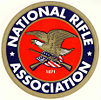National Rifle Association
This page was started in the framework of an Eduzendium course and needs to be assessed for quality. If this is done, this {{EZnotice}} can be removed.
| National Rifle Association | |
|---|---|

| |
| Website | www.nra.org |
| Legal status | 501(c)(4) |
| Founded | 1871, by Colonel William C. Church and General George Wingate |
| Headquarters | 11250 Waples Mill Road Fairfax , Virginia United States |
The National Rifle Association of America, or NRA, is a non-partisan, non-profit American interest group created to “preserve and defend” the Second Amendment of the United States Constitution. Founded in 1871 by Col. William C. Church and Gen. George Wingate, both Union veterans of the American Civil War, the group touts itself as America’s oldest civil rights organization.
Often referred to as one of the most powerful lobbying groups in the United States, the NRA boasts nearly four million members, according to the organization’s website.[1] The NRA trains approximately 750,000 gun owners each year, and promotes firearm safety with its training courses and educational programs.
A brief overview of your interest group (be sure to put its name in bold in the first sentence) and the scope of the article goes here.See the "Writing an Encyclopedia Article" handout for more details.
History
The National Rifle Association was founded shortly after the end of the American Civil War (1861-1865), but several decades after Samuel Colt opened the first private gun manufacturing facility in 1836.
By the end of the nineteenth century, factories were producing weapons at affordable prices, creating widespread individual ownership of guns [2]. The NRA trained many of these new gun owners, often men in the army, with its rifle ranges.
The group’s first rifle range, located on Long Island, was paid for by the New York stage legislature. In 1903 Congress set up the National Board for the Promotion of Rifle Practice, now known as the Civilian Marksmanship Program. The NRA helped to run this board, and Congress eventually gave surplus guns to NRA-sponsored rifle clubs, allowing the organization to expand westward (Cite Economist).
The tenor of the organization changed after World World II, as the NRA began to accommodate the recreational sportsman, even putting together an Olympic rifle team.
This section should describe the interest group's founding and development. It would probably be a good idea to divide it into chronological subsections, for example:
Founding
This subsection should provide some historical context for the founding of your group, explain the motivations behind it, and describe the steps taken and challenges faced by its founders to get the ball rolling.[3]
Current objectives and activities
This section should discuss the group's current initiatives and tactics for influencing political outcomes (which may or may not be very different from its original goals and modus operandi).[4]
Organizational structure
This section should describe the group's organizational structure, including its principal leadership positions and their current incumbents.[5]
Achievements
This section should recount the group's major achievements, including but not limited to legislative and/or legal victories.[6]
Public perception and controversies
In developing this final section, be especially careful about maintaining a neutral stance and tone. Your aim should be to document the public's perception of your group and/or any controversies in which it is or has been embroiled without weighing in with your own opinion about them.
References
- ↑ NRA "Brief History" Web page, accessed Aug. 30, 2009 from http://www.nra.org/aboutus.aspx
- ↑ Anonymous, "Guns in America: Arms and the man"Economist
- ↑ John Q. Sample, Why and How Interest Group X Was Founded. City: Publisher, 2015.
- ↑ "The Things We Do and How We Do Them," Interest Group X. 2006. Retrieved July 21, 2009 from http://www.interestgroupx.org/things_we_do.html
- ↑ First Author and Second Author, "The Organizational Structure of Interest Group X," Fake Journal of Nonexistent Scholarship 36:2 (2015) pp. 36-52.
- ↑ "Major Success for Interest Group X," Anytown Daily News, January 1, 2015, p. A6.